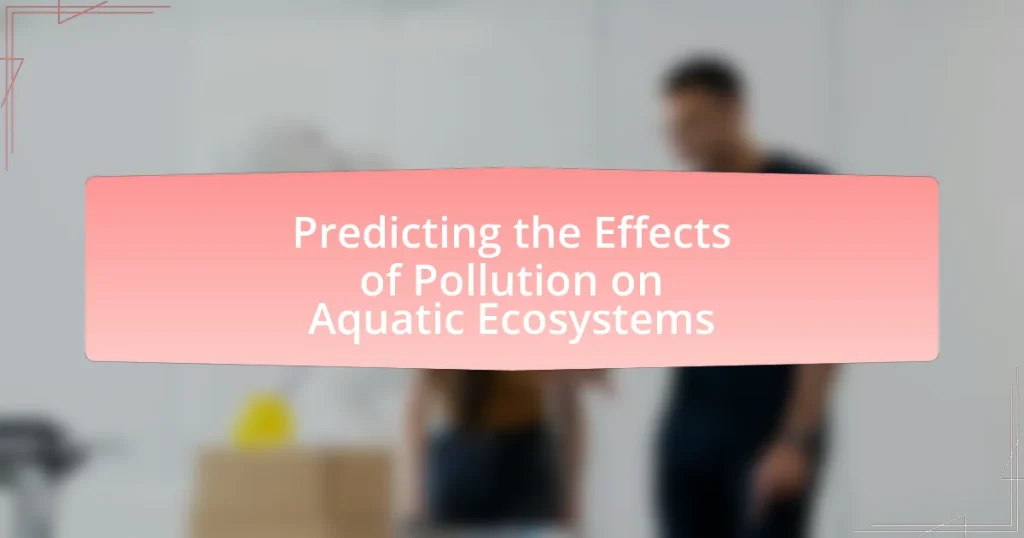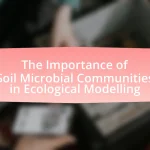The article focuses on predicting the effects of pollution on aquatic ecosystems, highlighting the main types of pollution, including chemical, plastic, nutrient, and thermal pollution. It details how these pollutants impact aquatic life, disrupt ecosystems, and lead to biodiversity loss. The article also discusses the sources of these pollutants, the methods used to predict their effects, and the economic implications of pollution on fisheries and local economies. Additionally, it outlines strategies for mitigating pollution effects and best practices for monitoring water quality, emphasizing the importance of effective management to protect aquatic environments.
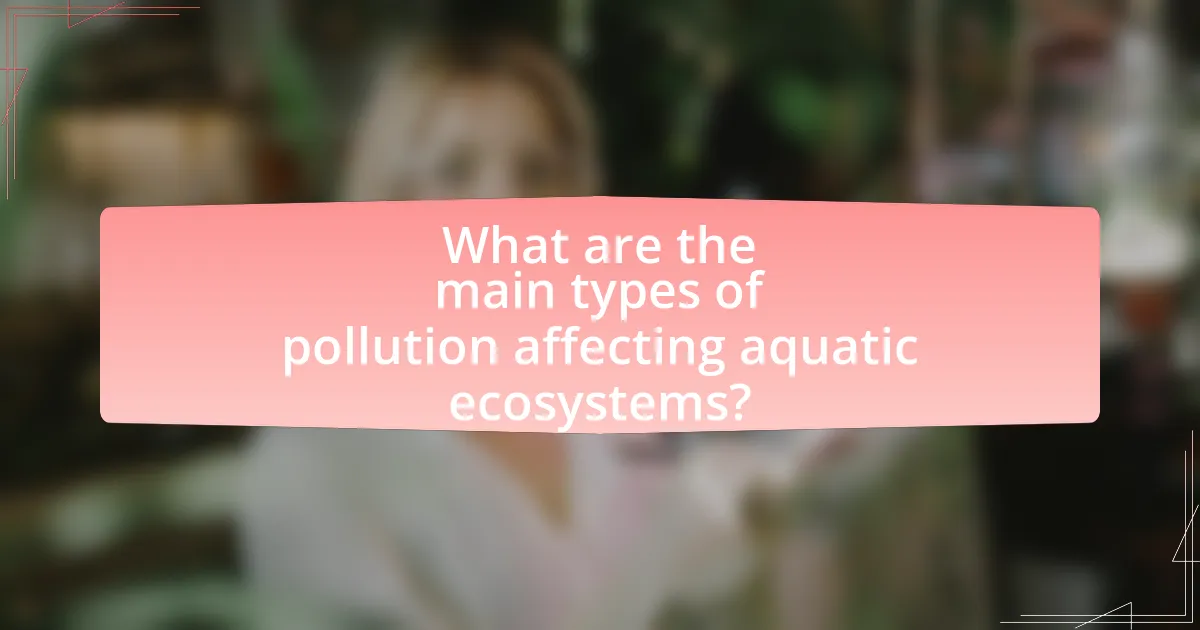
What are the main types of pollution affecting aquatic ecosystems?
The main types of pollution affecting aquatic ecosystems are chemical pollution, plastic pollution, nutrient pollution, and thermal pollution. Chemical pollution includes harmful substances like heavy metals and pesticides that contaminate water bodies, leading to toxic effects on aquatic life. Plastic pollution involves the accumulation of plastic debris, which can entangle marine organisms and introduce microplastics into the food chain. Nutrient pollution, primarily from agricultural runoff, causes eutrophication, resulting in oxygen depletion and harmful algal blooms that threaten aquatic species. Thermal pollution occurs when industrial processes discharge heated water into aquatic environments, disrupting the natural temperature balance and affecting species’ survival. Each type of pollution has significant and detrimental impacts on the health and biodiversity of aquatic ecosystems.
How do chemical pollutants impact aquatic life?
Chemical pollutants significantly harm aquatic life by disrupting ecosystems and causing physiological damage to organisms. For instance, heavy metals like mercury and lead accumulate in fish tissues, leading to bioaccumulation and biomagnification, which can result in reproductive failures and increased mortality rates. Additionally, pesticides and pharmaceuticals can alter the behavior and development of aquatic species, such as amphibians, leading to population declines. Research indicates that over 50% of freshwater fish species are threatened by pollution, highlighting the urgent need for effective pollution management strategies to protect aquatic ecosystems.
What specific chemicals are most harmful to aquatic organisms?
Heavy metals, pesticides, and pharmaceuticals are among the most harmful chemicals to aquatic organisms. Heavy metals such as mercury and lead can accumulate in the tissues of aquatic life, leading to toxicity and death. Pesticides like organophosphates and carbamates disrupt neurological functions in fish and invertebrates, causing mortality and reproductive issues. Pharmaceuticals, including hormones and antibiotics, can alter the behavior and physiology of aquatic species, leading to population declines. Studies have shown that even low concentrations of these chemicals can have significant adverse effects on aquatic ecosystems, highlighting their harmful nature.
How do these chemicals enter aquatic ecosystems?
Chemicals enter aquatic ecosystems primarily through runoff, wastewater discharge, and atmospheric deposition. Runoff occurs when rainwater or melting snow carries pollutants from land surfaces into rivers, lakes, and oceans. For instance, agricultural fertilizers and pesticides can be washed away from fields, leading to nutrient pollution in water bodies. Wastewater discharge from industrial facilities and sewage treatment plants introduces various chemicals directly into aquatic environments, contributing to contamination. Additionally, atmospheric deposition involves the settling of airborne pollutants, such as heavy metals and persistent organic pollutants, into water bodies through precipitation. Studies have shown that these pathways significantly impact water quality and aquatic life, highlighting the importance of monitoring and regulating chemical inputs into ecosystems.
What role does plastic pollution play in aquatic environments?
Plastic pollution significantly disrupts aquatic environments by harming marine life and altering ecosystem dynamics. It leads to ingestion and entanglement of marine organisms, which can result in injury or death. For instance, studies have shown that over 800 species are affected by marine debris, with many ingesting microplastics, which can cause internal injuries and toxicological effects. Additionally, plastic pollution contributes to habitat degradation, as larger debris can smother coral reefs and disrupt the natural behavior of aquatic species. The accumulation of plastics in water bodies also affects food webs, as toxins from plastics can bioaccumulate in organisms, ultimately impacting human health through seafood consumption.
How does plastic affect marine animals and their habitats?
Plastic significantly harms marine animals and their habitats by causing physical injuries, entanglement, and ingestion. Marine species, such as sea turtles and seabirds, often mistake plastic debris for food, leading to internal injuries, malnutrition, or death. For instance, a study published in the journal “Marine Pollution Bulletin” found that over 800 species are affected by marine debris, with many suffering from digestive blockages due to plastic ingestion. Additionally, plastic pollution disrupts habitats by smothering coral reefs and altering the structure of marine ecosystems, which can lead to decreased biodiversity. The accumulation of microplastics in the food chain further poses risks to marine life and human health, as these particles can carry toxic substances.
What are the long-term effects of plastic accumulation in water bodies?
The long-term effects of plastic accumulation in water bodies include significant harm to aquatic ecosystems, wildlife, and human health. Over time, plastics break down into microplastics, which can be ingested by marine organisms, leading to bioaccumulation of toxic substances in the food chain. Research indicates that approximately 1 million marine animals and countless fish are killed each year due to plastic pollution, as reported by the United Nations Environment Programme. Additionally, microplastics have been found in drinking water sources, posing potential health risks to humans. The persistence of plastics in aquatic environments disrupts habitats, alters species composition, and can lead to the decline of biodiversity.
How does nutrient pollution alter aquatic ecosystems?
Nutrient pollution significantly alters aquatic ecosystems by causing eutrophication, which leads to excessive growth of algae. This algal bloom depletes oxygen levels in the water, resulting in hypoxic conditions that can kill fish and other aquatic organisms. Studies indicate that nutrient runoff from agricultural practices contributes to this phenomenon, with the U.S. Environmental Protection Agency reporting that nitrogen and phosphorus from fertilizers are primary culprits. The decline in biodiversity and disruption of food webs further illustrate the detrimental impacts of nutrient pollution on aquatic environments.
What are the sources of nutrient pollution in water bodies?
Nutrient pollution in water bodies primarily originates from agricultural runoff, wastewater discharge, and urban stormwater. Agricultural runoff contributes excess nitrogen and phosphorus from fertilizers, which can lead to algal blooms. Wastewater discharge introduces nutrients from sewage and industrial processes, further exacerbating pollution levels. Urban stormwater collects pollutants from roads and landscapes, adding to nutrient loads in nearby water bodies. According to the U.S. Environmental Protection Agency, nutrient pollution is a leading cause of water quality impairment in rivers and lakes, affecting aquatic ecosystems and biodiversity.
How does nutrient pollution lead to harmful algal blooms?
Nutrient pollution leads to harmful algal blooms primarily through the excessive introduction of nitrogen and phosphorus into aquatic ecosystems. These nutrients, often from agricultural runoff, wastewater discharge, and urban stormwater, create an environment conducive to rapid algal growth. When nutrient levels exceed natural thresholds, algal populations can explode, resulting in blooms that can produce toxins harmful to aquatic life and human health. Studies have shown that areas with high nutrient concentrations, such as the Gulf of Mexico’s Dead Zone, experience significant algal blooms, which deplete oxygen levels and disrupt marine ecosystems.
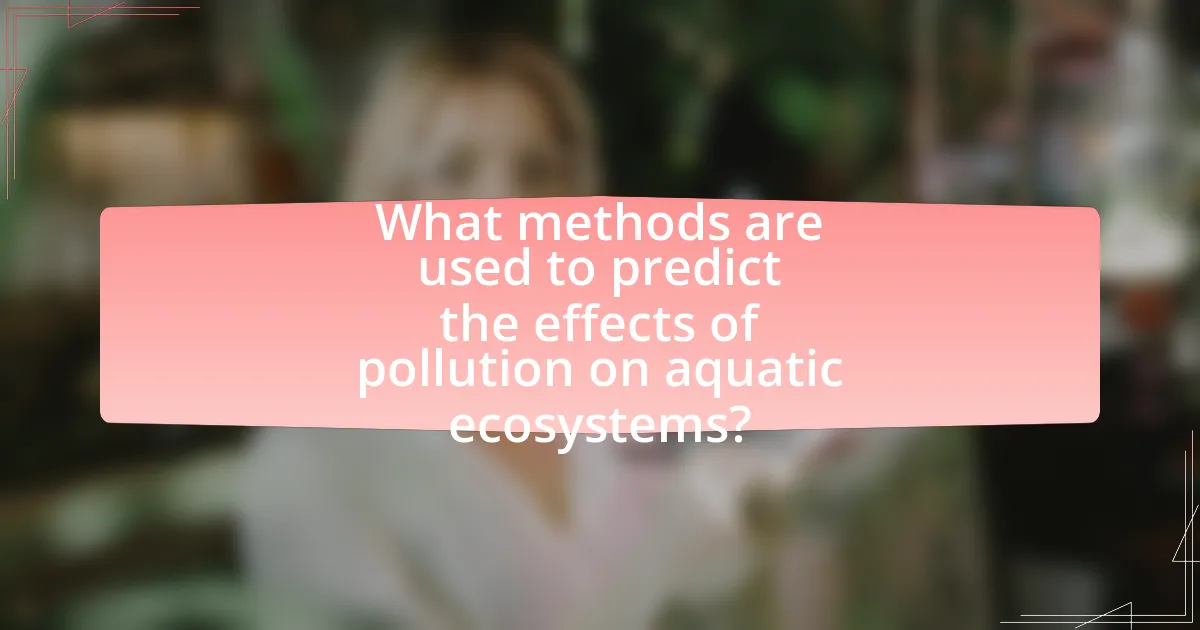
What methods are used to predict the effects of pollution on aquatic ecosystems?
Mathematical modeling, laboratory experiments, and field studies are commonly used methods to predict the effects of pollution on aquatic ecosystems. Mathematical models, such as ecological risk assessment models, simulate the interactions between pollutants and aquatic organisms, allowing researchers to estimate potential impacts. Laboratory experiments provide controlled environments to study the toxicity of specific pollutants on various aquatic species, yielding data on lethal and sub-lethal effects. Field studies involve monitoring real-world ecosystems to assess changes in biodiversity, water quality, and organism health in response to pollution, providing empirical evidence of pollution’s impact. These methods collectively enhance understanding and prediction of pollution effects on aquatic ecosystems.
How do scientists model the impact of pollutants on aquatic life?
Scientists model the impact of pollutants on aquatic life using mathematical and computational models that simulate the interactions between pollutants and aquatic organisms. These models incorporate data on pollutant concentrations, toxicity levels, and biological responses of various species to predict outcomes such as population dynamics and ecosystem health. For instance, the Ecological Risk Assessment framework is commonly employed, which evaluates the likelihood of adverse effects on aquatic organisms based on exposure levels and sensitivity. Additionally, field studies and laboratory experiments provide empirical data that validate these models, ensuring their accuracy in predicting real-world impacts.
What data is essential for creating accurate predictive models?
Accurate predictive models require comprehensive data on pollutant concentrations, aquatic species populations, water quality parameters, and environmental conditions. Pollutant concentration data, such as levels of heavy metals or nutrients, directly influences the health of aquatic ecosystems. Species population data provides insights into biodiversity and ecosystem resilience, while water quality parameters, including pH, temperature, and dissolved oxygen, are critical for understanding habitat suitability. Environmental conditions, such as flow rates and seasonal variations, further enhance model accuracy by accounting for dynamic ecosystem changes. Collectively, these data types enable the development of robust models that can effectively predict the impacts of pollution on aquatic ecosystems.
How do these models account for various environmental factors?
Models predicting the effects of pollution on aquatic ecosystems account for various environmental factors by integrating data on water temperature, pH levels, dissolved oxygen, and nutrient concentrations. These factors influence the biological and chemical processes within aquatic environments, affecting species distribution and ecosystem health. For instance, temperature variations can alter metabolic rates of aquatic organisms, while pH levels can impact the solubility of pollutants and their toxicity. Research has shown that models incorporating these variables can more accurately simulate ecosystem responses to pollution, as evidenced by studies that demonstrate a correlation between nutrient loading and algal blooms, which disrupt aquatic food webs.
What role do field studies play in understanding pollution effects?
Field studies are crucial for understanding pollution effects as they provide real-world data on how pollutants impact aquatic ecosystems. These studies allow researchers to observe the interactions between pollutants and various environmental factors, such as water chemistry, biological diversity, and ecosystem health. For instance, field studies have documented the decline in fish populations in areas with high levels of heavy metals, demonstrating a direct correlation between pollution and biodiversity loss. Additionally, they help identify specific pollution sources and their effects on local habitats, enabling targeted conservation efforts.
How are field studies designed to assess pollution impacts?
Field studies designed to assess pollution impacts involve systematic data collection in natural environments to evaluate the effects of pollutants on ecosystems. Researchers typically establish specific study sites that are representative of the area being assessed, ensuring a control site is included for comparison. Data collection methods may include water sampling, sediment analysis, and biological assessments of flora and fauna to measure changes in biodiversity and ecosystem health. For instance, studies often utilize bioindicators, such as specific fish or invertebrate species, to gauge the ecological effects of pollutants. These methodologies are validated through established protocols, such as those outlined by the U.S. Environmental Protection Agency, which emphasize the importance of replicability and statistical analysis in determining the significance of observed impacts.
What are the limitations of field studies in predicting pollution effects?
Field studies have several limitations in predicting pollution effects, primarily due to their inherent variability and lack of controlled conditions. These studies often face challenges such as the influence of confounding environmental factors, which can obscure the direct impact of pollutants on aquatic ecosystems. For instance, natural fluctuations in temperature, salinity, and biological interactions can significantly alter the responses of organisms to pollution, making it difficult to isolate specific effects. Additionally, field studies may not account for long-term exposure or cumulative effects of pollutants, as they typically capture only short-term snapshots of ecological responses. This limitation is compounded by the difficulty in replicating field conditions in a controlled manner, which can lead to inconsistent results across different studies.
How can remote sensing technology aid in pollution prediction?
Remote sensing technology aids in pollution prediction by providing real-time data on environmental conditions and pollutant levels. This technology utilizes satellite imagery and aerial sensors to monitor changes in land use, water quality, and atmospheric conditions, which are critical for identifying pollution sources and trends. For instance, studies have shown that remote sensing can detect chlorophyll concentrations in water bodies, indicating algal blooms often linked to nutrient pollution. Additionally, remote sensing can track thermal pollution by measuring surface temperatures, which affects aquatic ecosystems. The integration of these data into predictive models enhances the accuracy of pollution forecasts, allowing for timely interventions to protect aquatic ecosystems.
What types of data can be collected through remote sensing?
Remote sensing can collect various types of data, including spectral data, spatial data, and temporal data. Spectral data provides information about the electromagnetic spectrum reflected or emitted by objects, which is crucial for identifying materials and assessing their conditions. Spatial data offers information about the geographic location and distribution of features, enabling the analysis of land use, vegetation cover, and water bodies. Temporal data captures changes over time, allowing for the monitoring of environmental dynamics, such as pollution levels in aquatic ecosystems. These data types are essential for understanding and predicting the effects of pollution on aquatic ecosystems, as they facilitate the assessment of water quality, habitat changes, and the health of aquatic organisms.
How does remote sensing improve our understanding of pollution dynamics?
Remote sensing enhances our understanding of pollution dynamics by providing comprehensive, real-time data on pollutant distribution and concentration across large geographic areas. This technology utilizes satellite imagery and aerial sensors to monitor changes in land use, water quality, and atmospheric conditions, enabling researchers to identify pollution sources and track their movement over time. For instance, studies have shown that remote sensing can detect chlorophyll concentrations in water bodies, which serve as indicators of algal blooms often linked to nutrient pollution. Additionally, remote sensing data can be integrated with models to predict the impact of pollutants on aquatic ecosystems, facilitating better management and mitigation strategies.
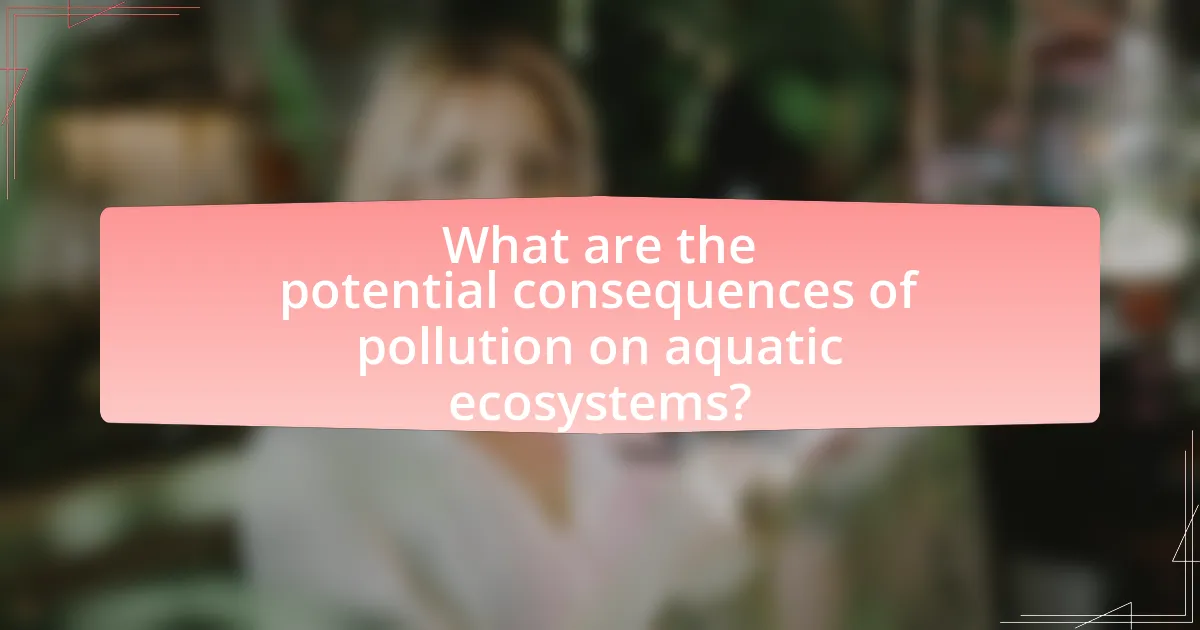
What are the potential consequences of pollution on aquatic ecosystems?
Pollution has severe consequences on aquatic ecosystems, leading to habitat degradation, loss of biodiversity, and disruption of food webs. Contaminants such as heavy metals, plastics, and nutrients can cause toxic effects on aquatic organisms, resulting in decreased populations and altered community structures. For instance, studies show that nutrient pollution can lead to harmful algal blooms, which deplete oxygen levels and create dead zones, severely impacting fish and other marine life. Additionally, pollutants can bioaccumulate in the food chain, posing risks to predators, including humans, who consume contaminated fish.
How does pollution affect biodiversity in aquatic environments?
Pollution significantly reduces biodiversity in aquatic environments by introducing harmful substances that disrupt ecosystems. Contaminants such as heavy metals, plastics, and nutrients lead to habitat degradation, species decline, and altered food webs. For instance, a study published in the journal “Environmental Pollution” found that increased nutrient runoff from agricultural practices causes algal blooms, which deplete oxygen levels and create dead zones, severely impacting fish and invertebrate populations. Additionally, pollutants can cause direct toxicity to aquatic organisms, leading to decreased reproductive success and increased mortality rates. These factors collectively diminish species diversity and disrupt the balance of aquatic ecosystems.
What species are most vulnerable to pollution effects?
Aquatic species such as amphibians, fish, and certain invertebrates are most vulnerable to pollution effects. Amphibians, like frogs, are particularly sensitive due to their permeable skin, which allows pollutants to enter their bodies easily. Fish species, including salmon and trout, are affected by heavy metals and chemicals that disrupt their reproductive systems and overall health. Invertebrates, such as mollusks and crustaceans, are also at risk as they can accumulate toxins in their bodies, leading to population declines. Studies have shown that these species often serve as bioindicators, reflecting the health of their ecosystems and the impact of pollution.
How does loss of biodiversity impact ecosystem services?
Loss of biodiversity negatively impacts ecosystem services by reducing the resilience and functionality of ecosystems. Diverse species contribute to various services such as pollination, water purification, and nutrient cycling; their decline can lead to diminished productivity and stability. For instance, a study published in the journal “Nature” found that ecosystems with higher biodiversity are more effective at providing services like carbon storage and soil fertility, demonstrating that species loss directly correlates with decreased ecosystem performance.
What are the economic implications of pollution on aquatic ecosystems?
Pollution in aquatic ecosystems leads to significant economic implications, primarily through the degradation of fisheries, tourism, and water quality. The decline in fish populations due to contaminants can reduce commercial and recreational fishing revenues, with the U.S. fishing industry alone generating approximately $200 billion annually. Additionally, polluted waters deter tourists, impacting local economies reliant on recreational activities, which can account for billions in lost revenue. Furthermore, the costs associated with water treatment increase as pollution levels rise, with municipalities spending millions to ensure safe drinking water. These economic impacts underscore the necessity of addressing pollution to protect aquatic ecosystems and the economies that depend on them.
How does pollution affect fisheries and local economies?
Pollution negatively impacts fisheries and local economies by degrading water quality and harming aquatic life. Contaminants such as heavy metals, pesticides, and plastics can lead to fish kills, reduced fish populations, and the bioaccumulation of toxins in fish, making them unsafe for consumption. For instance, a study by the National Oceanic and Atmospheric Administration (NOAA) found that harmful algal blooms, often fueled by nutrient pollution, can lead to significant fishery closures, resulting in economic losses exceeding $82 million annually in the United States. Consequently, local economies that rely on fishing and tourism suffer from decreased income, job losses, and increased health risks for communities dependent on these resources.
What are the costs associated with pollution cleanup and restoration?
The costs associated with pollution cleanup and restoration can range from thousands to billions of dollars, depending on the severity and extent of the pollution. For example, the U.S. Environmental Protection Agency (EPA) estimates that cleaning up a single contaminated site can cost between $1 million and $50 million, while large-scale projects, such as the restoration of the Chesapeake Bay, have projected costs exceeding $10 billion. These costs encompass various factors, including assessment, remediation, monitoring, and long-term management of the affected ecosystems. Additionally, the economic impact on local communities, such as loss of tourism and fishing revenue, further contributes to the overall financial burden of pollution cleanup and restoration efforts.
What strategies can be implemented to mitigate pollution effects?
Implementing strategies such as reducing industrial emissions, enhancing wastewater treatment, and promoting sustainable agricultural practices can effectively mitigate pollution effects. Reducing industrial emissions involves adopting cleaner technologies and stricter regulations, which can lower airborne pollutants that affect aquatic ecosystems. Enhancing wastewater treatment ensures that contaminants are removed before water is discharged into bodies of water, thus protecting aquatic life. Promoting sustainable agricultural practices, such as reducing pesticide and fertilizer use, minimizes runoff that can lead to nutrient pollution in aquatic environments. These strategies are supported by studies indicating that improved regulations and practices can significantly reduce pollution levels and enhance ecosystem health.
How can policy changes contribute to reducing pollution in aquatic ecosystems?
Policy changes can significantly reduce pollution in aquatic ecosystems by implementing stricter regulations on industrial discharges and agricultural runoff. For instance, the Clean Water Act in the United States has led to a 40% reduction in water pollution since its enactment in 1972, demonstrating the effectiveness of regulatory frameworks. Additionally, policies promoting sustainable agricultural practices, such as nutrient management plans, can minimize the runoff of fertilizers and pesticides into waterways, further protecting aquatic habitats. These changes not only enhance water quality but also support biodiversity and ecosystem health, as evidenced by improved fish populations in regions where such policies have been enforced.
What best practices can industries adopt to minimize their pollution footprint?
Industries can minimize their pollution footprint by implementing practices such as adopting cleaner production technologies, enhancing waste management systems, and utilizing renewable energy sources. Cleaner production technologies, which focus on reducing waste and emissions at the source, can lead to significant reductions in pollutants. For instance, the adoption of advanced filtration systems can decrease water contaminants by up to 90%. Enhanced waste management systems, including recycling and proper disposal methods, can prevent hazardous materials from entering ecosystems. Furthermore, transitioning to renewable energy sources, such as solar or wind, can reduce greenhouse gas emissions significantly; studies show that renewable energy can cut emissions by 70% compared to fossil fuels. These practices collectively contribute to a substantial decrease in industrial pollution and its adverse effects on aquatic ecosystems.
What are the best practices for monitoring pollution in aquatic ecosystems?
The best practices for monitoring pollution in aquatic ecosystems include regular water quality assessments, the use of bioindicators, and the implementation of remote sensing technologies. Regular water quality assessments involve measuring parameters such as pH, dissolved oxygen, turbidity, and concentrations of pollutants like heavy metals and nutrients, which provide a comprehensive understanding of the ecosystem’s health. Bioindicators, such as specific species of fish or invertebrates, serve as effective tools for assessing the ecological impact of pollution, as their presence or absence can indicate the level of environmental stress. Remote sensing technologies, including satellite imagery and aerial surveys, allow for large-scale monitoring of water bodies, enabling the detection of changes in water quality and land use that may contribute to pollution. These practices are supported by studies indicating that integrated monitoring approaches yield more accurate and timely data, facilitating better management and remediation efforts in aquatic environments.
